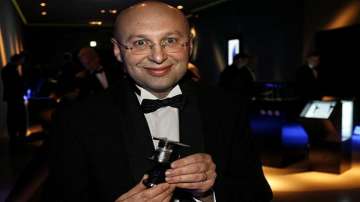'Crazy idea' fetches Stefan Hell the Nobel Prize
At the 107th Indian Science Congress in Bengaluru on Friday, the Nobel laureate shared his experience.

What German scientist Stefan Hell initially thought was a crazy idea later fetched him the Nobel Prize in Chemistry in 2014. His work on breaking the diffraction barrier in microscopy could prove significant in finding remedies to incurable diseases like cancer and neuro-degenerative diseases. At the 107th Indian Science Congress in Bengaluru on Friday, the Nobel laureate shared his experience. "Throughout the 20th century, scientists believed there is no way to get the highest spatial resolution that only was released," Hell told the audience. "But now, the development of this microscopy, which I'm responsible for, showed that this is not true. You can go beyond that. You can have a higher spatial resolution, you can clearly see that here there are filaments of resolve that are not resolved in a normal mode."
The microscopy he developed is significant as it has the ability to peep deep into the cells to show how they function.
He said it would enable one learn how cells work even at at a fundamental level.
"And you don't forget every disease no matter what it is — infection, cancer, whatever, neurodegenerative disease — in the end, it's a malfunctioning of the cell."
Once it is understood how cells work and how the proteins are arranged inside a cell and what they do, it would become easy to understand why they malfunction, the scientist said.
"And I believe that over the coming years it will help us tremendously to understand diseases or to find remedies or to counteract them," Hell told the gathering.
Giving an interesting anecdote, he said he hit upon the idea while working for a start-up company that had developed light microscopes for the inspection of computer chips.
His job was to measure the size of the computer chips.
Anxious to pursue fundamental physics, Hell ended up scanning the chips with microscopes of the 19th century, frustrating him, as he felt he was wasting his time.
Before he could slip into depression, it occurred to him that there could be some fundamental problem left in this in microscopy, such as breaking the diffraction barrier.
"I realised that breaking the diffraction barrier, that would be worthwhile working on. This is how I got to think about the problem, the Nobel laureate said.
He said working on breaking the diffraction barrier was a crazy idea because textbooks said it never works.
To the audience of young students and budding scientists, Stefan Hell said people often ask him what the key to success is, to which his reply has always been: "Aim high, stay grounded.
And if you are lucky and have a good idea, you might even hit the bulls eye."
Also Read: Private trainer aircraft crashes in MP's Sagar, two killed
Also Read: Yogi asks authorities to come up with metro station near Gorakhpur railway station